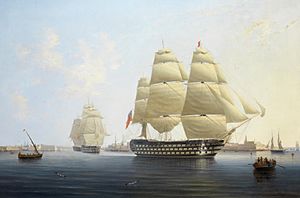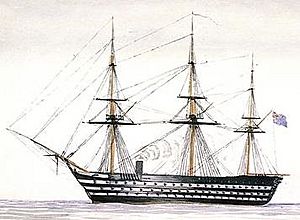Sir William Martin, 4th Baronet facts for kids
Quick facts for kids
Sir William Martin, Bt
|
|
|---|---|
| Born | 5 December 1801 |
| Died | 24 March 1895 (aged 93) Winchfield, Hampshire |
| Allegiance | |
| Service/ |
|
| Years of service | 1813–1870 |
| Rank | Admiral |
| Commands held | HMS Fly HMS Samarang HMS Queen HMS Trafalgar HMS Prince Regent Channel Squadron Portsmouth Dockyard Mediterranean Fleet Plymouth Command |
| Battles/wars | Peruvian War of Independence |
| Awards | Knight Grand Cross of the Order of the Bath |
Sir William Fanshawe Martin (born December 5, 1801 – died March 24, 1895) was a very important officer in the Royal Navy. He helped British traders in Peru during a war there. Later, he became a top naval leader, pushing for Britain to get its first ironclad warship. These were powerful new ships made of iron! He also led the Mediterranean Fleet, helping during a time of trouble in Italy. He made the navy's rules better and taught sailors new ways to move steam-powered ships.
Contents
William Martin was born on December 5, 1801. His father, Sir Thomas Martin, was also a famous admiral. William joined the Royal Navy in June 1813 when he was just 11 years old. He served on several ships, including HMS Alceste and HMS Prince Regent.
In December 1820, he became a lieutenant. This meant he was a junior officer. He then served on ships like HMS Forte and HMS Aurora. These ships were on the South America Station, which meant they were in the waters near South America.
Helping British Traders in Peru
In February 1823, William Martin was promoted to commander. He was given command of a small warship called HMS Fly. At this time, there was a war happening in Peru, called the Peruvian War of Independence. Martin and his ship helped protect British traders and their goods in a port called Callao. This was very important for Britain's business.
In June 1824, he became a captain. He commanded HMS Samarang in the Mediterranean Sea. Later, he commanded large warships like HMS Queen and HMS Trafalgar. These were huge ships with many cannons. By December 1849, he was in charge of the Channel Squadron, a group of ships protecting the English Channel.
Leading the Fleet
William Martin continued to rise through the ranks. In May 1853, he became a rear-admiral. He was put in charge of the Portsmouth Dockyard, a very important naval base where ships were built and repaired.
Pushing for Ironclad Warships
In February 1858, he became a vice-admiral. He was then given a very important job: First Naval Lord. This meant he was one of the most senior officers in the Royal Navy, helping to make big decisions. In this role, he strongly argued that Britain needed to build its first ironclad warship. These ships had thick iron armor, making them much stronger than older wooden ships. This was a big step forward for naval technology!
Commander of the Mediterranean Fleet
In April 1860, Martin became the Commander-in-Chief of the Mediterranean Fleet. This was a very powerful group of ships. He flew his flag on HMS Marlborough. While in this role, he did several important things:
- He helped during a time of trouble in Italy between 1860 and 1861.
- He improved the rules and discipline for sailors in his fleet.
- He created new ways for steam-powered ships to move and fight together. This was important because steam ships were new, and the navy needed to learn how to use them best.
In November 1863, he became a full admiral. He also inherited the title of Baronet, becoming Sir William Fanshawe Martin, 4th Baronet. He continued to serve the navy, becoming Commander-in-Chief at Plymouth in October 1866. He received a very high honor, the Knight Grand Cross of the Order of the Bath, in May 1873.
Sir William Martin passed away on March 24, 1895, at his home in Winchfield. He was a dedicated naval officer who helped modernize the Royal Navy during a time of great change.
Family Life
Sir William Martin was married twice. His first wife was Anne Best, and after she passed away, he married Sophia Elizabeth Hurt. He had five daughters and one son. His son, Sir Richard Byam Martin, became the 5th Baronet after him.



